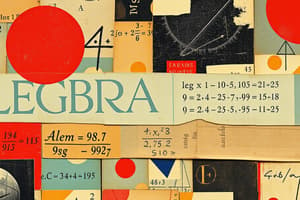Podcast
Questions and Answers
What is an arithmetic sequence?
What is an arithmetic sequence?
- A sequence where no two terms are the same
- A sequence where each term is found by multiplying the previous term by the same number
- A sequence where each term is found by adding the same number to the previous term (correct)
- A sequence of purely random numbers
What is the degree of a polynomial?
What is the degree of a polynomial?
The greatest degree of any term in the polynomial.
What is end behavior in graphing?
What is end behavior in graphing?
The behavior of the graph as x approaches positive infinity or negative infinity.
What is a geometric sequence?
What is a geometric sequence?
What is a horizontal asymptote?
What is a horizontal asymptote?
What is an identity in algebra?
What is an identity in algebra?
What is multiplicity concerning polynomials?
What is multiplicity concerning polynomials?
Define a polynomial function.
Define a polynomial function.
What is a rational function?
What is a rational function?
What is a relative maximum?
What is a relative maximum?
What is a relative minimum?
What is a relative minimum?
What is a sequence?
What is a sequence?
What is a term in a sequence?
What is a term in a sequence?
Define a vertical asymptote.
Define a vertical asymptote.
What are integers?
What are integers?
What is an even number?
What is an even number?
What is an odd number?
What is an odd number?
Define a rational number.
Define a rational number.
What is a polynomial?
What is a polynomial?
What is a factor?
What is a factor?
What does it mean to factor a polynomial?
What does it mean to factor a polynomial?
What is the graph of a function?
What is the graph of a function?
What are the intercepts of a graph?
What are the intercepts of a graph?
What is the x-intercept?
What is the x-intercept?
What is the y-intercept?
What is the y-intercept?
What are the zeroes of a function?
What are the zeroes of a function?
Flashcards are hidden until you start studying
Study Notes
Algebra 2 Key Concepts
-
Arithmetic Sequence: A sequence where each term is found by adding a constant value to the previous term.
-
Degree of a Polynomial: The highest exponent of any term within the polynomial indicates its degree.
-
End Behavior: Describes how the graph of a function behaves as the input approaches positive or negative infinity.
-
Geometric Sequence: A sequence in which each term is obtained by multiplying the prior term by a fixed constant.
-
Horizontal Asymptote: A line that represents where the graph approaches as it goes towards infinity but never actually intersects.
-
Identity: An equation that holds true for every possible value of the variable.
-
Multiplicity: Refers to the number of times a given factor appears in the polynomial's factored form.
-
Polynomial Function: A function expressed as the sum of multiple terms, each consisting of a constant multiplied by a variable raised to a non-negative integer power.
-
Rational Function: Defined as a function expressed as the ratio of two polynomials.
-
Relative Maximum: A point on a graph indicating that no nearby points have a higher y-coordinate.
-
Relative Minimum: A point on a graph where no nearby points have a lower y-coordinate.
-
Sequence: An ordered list of numbers that can continue indefinitely, such as the series of odd positive integers.
-
Term of a Sequence: An individual number within a sequence.
-
Vertical Asymptote: A vertical line that a graph approaches but never crosses, indicating behavior of the function.
-
Integer: Whole numbers that can be positive, negative, or zero.
-
Even Number: An integer that is divisible by 2 without remainder.
-
Odd Number: An integer whose last digit is 1, 3, 5, 7, or 9.
-
Rational Number: A number that can be expressed as a ratio between two integers.
-
Polynomial: An expression made by adding together several terms.
-
Factor: A number that divides another number exactly, contributing to the multiplication that yields a product.
-
Factoring a Polynomial: The process of expressing a polynomial as a product of simpler polynomials.
-
Graph of a Function: A visual representation of the relationship between the input values (domain) and their corresponding function outputs.
-
Intercepts of a Graph: Points where the graph intersects the axes; includes both x-intercepts and y-intercepts.
-
X-Intercept: The value of x at which the graph intersects the x-axis.
-
Y-Intercept: The value of y at which the graph intersects the y-axis.
-
Zeroes of a Function: Specific inputs that result in an output of zero for the function.
Studying That Suits You
Use AI to generate personalized quizzes and flashcards to suit your learning preferences.




